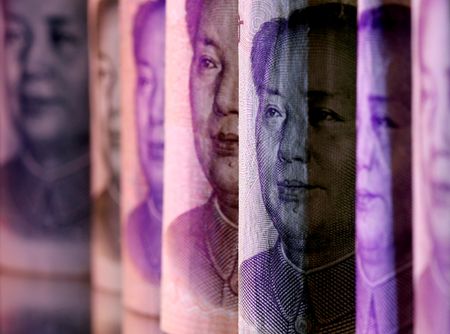By Winni Zhou, Brenda Goh and Tom Westbrook
SHANGHAI/SINGAPORE (Reuters) -China’s yuan has skidded to six-month lows against the dollar and analysts say it could weaken further as investors fret over a bumpy pandemic recovery in the world’s second-largest economy.
Disappointing economic data, widening yield differentials with the United States, upcoming corporate dividend payments and continued capital outflows through foreign selling of stocks and bonds have combined to drag the currency down to levels last seen in November.
The yuan has depreciated more than 5% against the surging dollar since the highs hit in January, when global markets embraced China’s border reopening, and is one of the worst performing Asian currencies this year. It last traded at 7.0585 per dollar on Friday.
“The yuan suffers as China’s reopening story is less appealing than before, and there is no sign of further stimulus,” said Gary Ng, senior economist for Asia Pacific at Natixis.
“A weaker currency at the current juncture can help export performance, especially as global trade is shrinking this year.”
Exports have been one of the few bright spots for the Chinese economy over the past few years but new orders have been falling in recent months amid softening global demand.
Sources told Reuters that the commerce ministry has asked exporters, importers and banks recently about their currency strategies and how a weakening yuan could affect their businesses.
To be sure, the central bank has ample policy tools to prevent excess currency movements. The People’s Bank of China (PBOC) said last month that it will resolutely curb large fluctuations in the exchange rate and study the strengthening of self-regulation of dollar deposits.
“Expectations of financial institutions, enterprises and residents on the exchange rate are generally stable, which is a solid foundation and strong guarantee for the smooth operation of the foreign exchange market,” the central bank said in the statement.
However, despite the yuan’s quickening tumble over the past month, traders have only reported a few occasions when state banks have been suspected of stepping in to support the currency.
The PBOC did not immediately respond to Reuters request for comments.
“The PBOC essentially appears content to let the rising U.S. dollar buoy USD/CNY higher, amid China’s fading growth momentum,” said Alvin Tan, head of Asia FX strategy at RBC Capital Markets.
“After all, currency depreciation is a form of monetary easing,” Tan said, maintaining his forecasts for the yuan to trade at 7.1 at the end of the third quarter before finishing the year at 7.05.
Tommy Wu, senior China economist at Commerzbank, also said the central bank “appears to tolerate a weaker yuan,” noting its recent daily official yuan midpoint guidance rates have all came in line with market expectations.
Still, economists and analysts don’t expect sharp falls from here on. Among half of a dozen of global investment houses surveyed by Reuters this week, all said they don’t foresee the yuan weakening beyond 7.3 this year, the lows hit in 2022 as strict anti-virus curbs battered the economy.
“A weaker yuan helps exporters when they convert the dollar receivables to yuan,” said Barclays’ FX strategist Lemon Zhang. “But a weak currency expectation going forward is not helping capital flows, as investors are concerned about FX losses when they look at yuan-denominated assets.”
A weaker yuan might also temper deflationary pressures being seen in parts of the economy due to weak domestic demand.
However, implied volatility for the currency, an options market gauge of future volatility, has been fairly stable. The one-month tenor stood at 4.5, the highest since April. And six-month yuan traded in forwards market was priced at 6.96 per dollar.
Some market watchers suspect the PBOC could set a cap on dollar deposit rates, a move that could encourage companies to liquidate their large dollar positions to ease downside pressure on the yuan.
“Chinese officials will not step in unless the spot yuan weakens quickly through 7.2,” said Serena Zhou, senior China economist at Mizuho Securities.
“Note that the PBOC has not intervened with any of its policy tools, such as the ‘counter-cyclical factor’ in pricing the yuan fixing rate or FX risk reserve ratio, to shore up the yuan.”
(Reporting by Winni Zhou and Brenda Goh in Shanghai, Tom Westbrook in Singapore; Editing by Kim Coghill)





